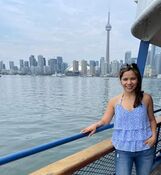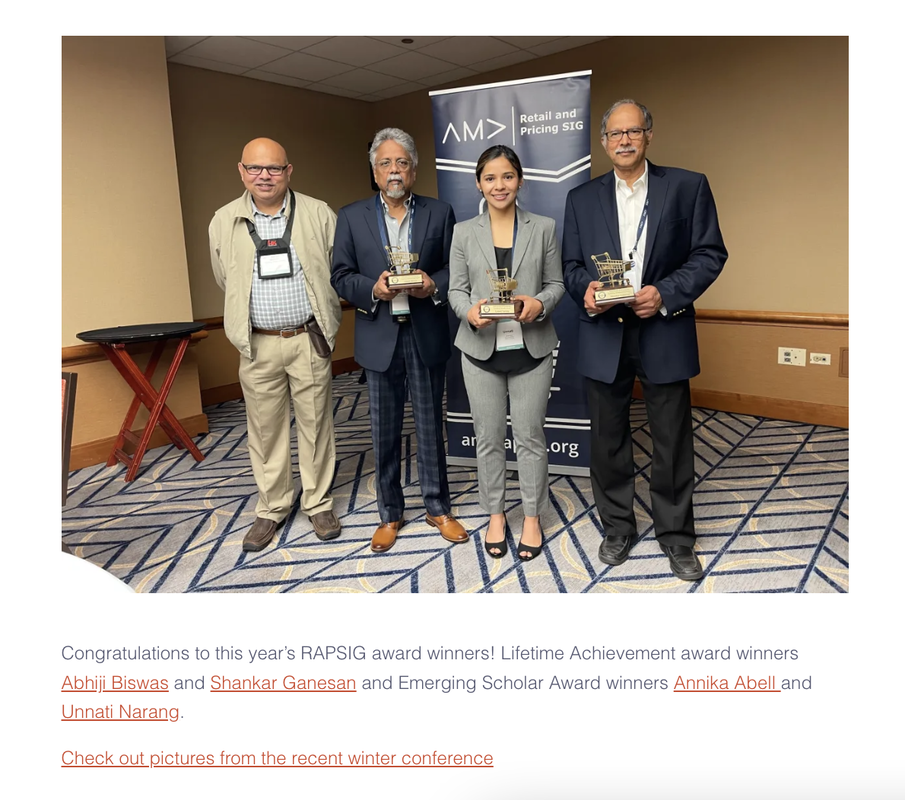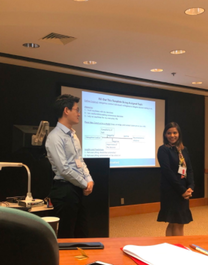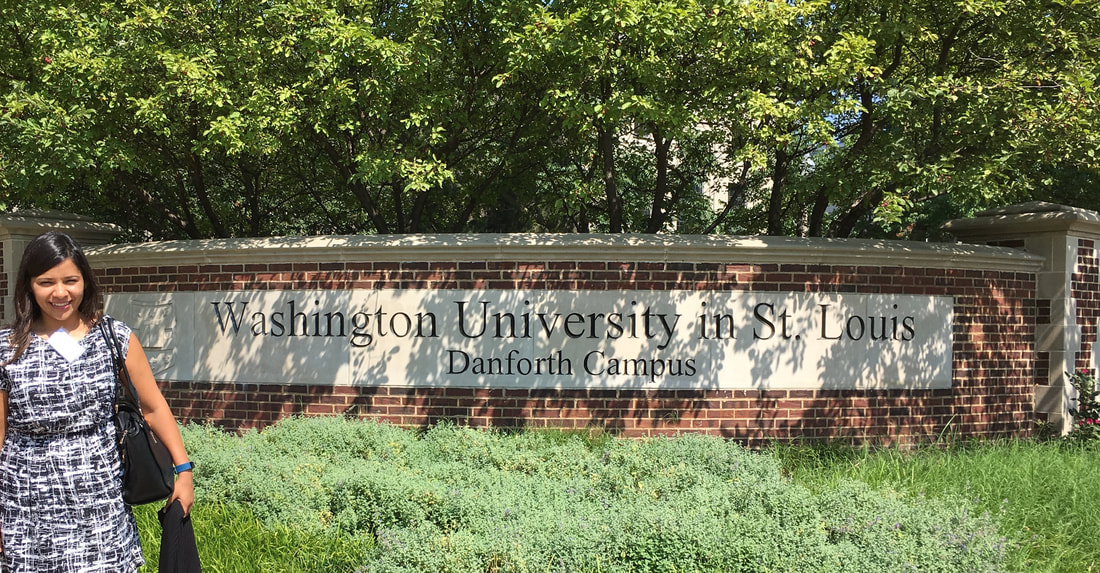|
0 Comments
 This post describes my recent research visit to the University of Toronto in June 2022. It's meant to serve as a potential guide for other junior faculty interested to plan a research visit (i.e., an ultra mini sabbatical, or ums). I cover topics, such as how I started thinking about ums, how I planned it, what helped me get the most out of it and how you can still have fun while working and traveling. I recently discovered that many junior faculty and students have found my blog and informal musings about academic life in #marketing useful. How did I discover this? At the virtual Marketing Science conference, I “ran into” (at the Gather Town virtual simulation) at least three PhD students from three different schools who said that they had read my blog (and my papers – whoa!) and that it helped them decide to pursue their PhD. One even said that I MUST continue writing these posts. In the spirit of believing that maybe I do have something useful to say, this post is dedicated to a recent experience I had: a short research visit to another university, i.e., University of Toronto, over the summer. I think of this visit as an ultra-mini sabbatical or ums, just like the filler word umm, symbolizing a pause, although a deliberate one. For those of you who don’t know me, I’m currently finishing my second year as an Assistant Professor of Marketing at the University of Illinois at Urbana-Champaign. This means that a fair bit of my dissertation research is wrapping up (hopefully) and that I’m on the cusp of something exciting i.e., developing new papers and crafting my research identity. All of this, while teaching three different courses including an online MBA course and MOOC on Applying Data Analytics in Marketing, mentoring PhD and Masters' students, and serving my profession, department, and school in various ways. So, what was I doing in Toronto? What prompted my visit? What were the pros and cons, and how did I make the most of it? Origin of my ums I first started thinking about ums when I saw a Twitter post by another assistant professor of marketing, saying he was going to spend some time in Italy visiting another school. Some universities have a structure and a more formal process for visiting scholars but for most, if you know someone there, perhaps a senior mentor, it could be worth exploring informally if the visit makes sense. The purpose of these visits can vary greatly depending on what you want out of them. You can meet and learn about various faculty in the department, get feedback on your papers, start new collaborations, and work on existing projects if you already have co-authors at that school. Since a full sabbatical is often not feasible or recommended for junior faculty, a mini sabbatical is a potential path that gives you more time compared with a typical 2-day visit for a research seminar but is shorter than a one-year commitment. I wanted to visit the Rotman School of Management at the University of Toronto for various reasons. First, I had visited them for a job talk during my academic job market year. They had seen my job market paper during my campus visit. In fact, the feedback I had received during my presentation and meetings there had already been super helpful on my earlier drafts. This is also the paper I’m currently revising and one that could benefit from immediate feedback before I sent it back to the journal. Second, they’d been very warm and receptive during my last visit, and I had since been in touch with several of the faculty there. One of their former PhD students is also my very good colleague and friend at the U of I and I also know her co-authors well. Third, I have overlapping research interests, both in methods and topics, with multiple faculty members in their marketing group. When I wrote to them exploring a potential visit, I also learned that most faculty I’d want to meet with was around in the summer. Finally, my cousin had serendipitously just moved from New Delhi to Toronto in May. So, I could also get to see her. Planning the ums The two big considerations for planning the ums are the visit timing and budget. The timing is important for both strategic and tactical reasons. Strategically, it makes sense to visit when you have projects at various stages in your pipeline. Depending on the faculty or PhD student you are meeting and the amount of time you have with them, it could help to have some advanced papers waiting revision, new working papers that are not yet submitted and a few new ideas you may be on the verge of starting or may have collected data for. Tactically, my visit was ideal during the summer. At least in 2022, summer is the only time I don’t teach (since I’ve borrowed my future Spring ‘23 teaching into Fall ‘22). This is also a summer when the global pandemic has subsided, and people are more available to meet in person. Depending on the school and department, it might also make sense to visit during your non-teaching semester if more faculty members are around at that time and/or you want to attend their regular seminar series, etc. Paperwork, such as getting a work permit in another country, may also influence the timing of visit. Finally, the timing should also make sense personally, especially if you have children and may have to visit with family. I have two dogs and a cat, and my husband was more than happy to watch them. His work is also only a five-minute commute from our home, so he could walk them during his lunch hours. The budget for the visit is another important consideration, particularly when visiting a major (and expensive!) city. Most schools can support accommodation and travel for a few days if you are giving a talk but will not be able to support longer stays. They might be able to offer an office or working space, access to the building, and Internet credentials. One way to fund an ums is to set aside some of your own research and travel/conference funds. You can also combine the trip with a conference in that area or close to the airport you’re flying from, if you don’t live near an airport. I was going to drive from Champaign to Chicago to present at the Advances with Field Experiments conference, so I planned my visit right after that. Chicago is also the nearest airport for me to fly to Toronto, so I flew from there directly. Another suggestion for keeping the visit affordable is to explore accommodation options on campus. I was able to stay at New College Residence at one sixth the cost of a hotel. Living close to the campus you’re visiting also allows you more flexibility (and less Ubers!). If you’re a gym-fanatic like me, there are also always free gym trials or short-term memberships available. Finally, if your accommodation provides a kitchen, consider traveling with basic cooking equipment. I packed a small pan with me and pretty much made myself an egg-white omlette every morning for breakfast. This is also healthier option, especially since you’ll likely end up getting several meals outside for lunch meetings, etc. During the ums I have a bunch of advice for what to do during the ums. First, make sure everyone (at least anyone you plan to meet) in the department knows you are visiting. You can do this by sending the faculty an email a week or more before you go. In my case, I had been in touch with at least two of the senior faculty there since April for my June visit. I was sharing my office with a junior faculty, who’d herself reached out to me a week before to let me know about being officemates. I’d also emailed most of the other faculty individually a week before the visit. In general, 90% of them said they’d be around and would love to meet. Instead of formally setting up doodle or something (who wants to deal with this super formally during a summer visit?! Of course, you can if that’s what you prefer), I started maintaining a google doc with my own itinerary and booking meeting times at my end. I wanted to make sure I wasn’t double-booked, that I didn’t miss any meetings, and that I was tracking meeting-related conversations across all possible conversation channels (e.g., two PhD students reached out to me on Twitter and Facebook to set up coffee chats). Second, make sure you plan ahead of the meetings. While ums is not a campus visit and you don’t need to read everyone’s entire set of research papers, it helps to know what they are doing and what their recent research projects are about. Why? In my experience and conversations, this helped me select the right projects from my pipeline to talk about and the right questions to ask. I learned, for example, that someone I was meeting for lunch had recently published a paper on giving incentives for COVID vaccines. While I don’t have a COVID-related project, I have a new project on financial- and non-financial incentives for going to the gym. It ended up being a meaningful conversation and he gave me several ideas for potential new experimental designs as well as literature to consult. Third, build in some deliberate pauses or gaps between meetings. If I had a meeting at 2pm, I’d not schedule my next one until 4pm. I don’t think I did this on purpose so much, but it worked great because sometimes we ended up going for a long-ish walk to talk, and I didn’t need to rush anyone for my next meeting. This is the kind of rush you’d typically experience in a 2-day research talk visit. In some of my longer meetings, the first half hour or so could be dedicated to a specific project or a warm-up conversation, so the real topics of connection or possibility of a collaboration would not even come up until much later. Having less time-pressured meetings was a great benefit of a longer visit! Fourth, don’t hesitate to reach out to someone and meet multiple times. There are no rules. Again, unlike a 2-day seminar visit, you can find opportunities for continuing your conversation. I met with a junior colleague who is at the same career stage as me once for a quick chat in the office, then for dinner (it happened to be my birthday that week, so we celebrated!), and then again over brunch. It wasn’t until the third conversation that we even explored any ideas about potentially working together. Similarly, a senior faculty member gave me some excellent feedback for my job market paper, so I was able to circle back and meet with him the following week to share what I was finding based on the analysis he had recommended and get detailed feedback on my overall research portfolio. In another case, a senior faculty member wanted to meet a second time to discuss my marketing analytics syllabus in detail. The opportunities for multiple meetings can be rich and rewarding for everyone. Finally, don’t overplan. LOTS of work and conversations can happen serendipitously. During my visit, I learned that someone else in quantitative marketing was also visiting Toronto. I’d talked to him virtually before. I reached out to him and was able to meet in person for a great conversation! Stuff Zoom can’t do justice to :) Work-life balance in ums Last but not the least, an important goal of ums is to reset. It can allow you to step out of your comfort zone and routine, and to try something different. Travel gives you a chance to step away from the structure of your daily life. Make sure to enjoy it. During the weekend and some of the evenings, for example, I explore Toronto Islands, the Little Italy food festival, and dinner with my cousin. Cheers to a dream summer, and to many of you, hopefully exploring your own ums after reading this!
1. Mobile:
2. AI and robotics
3. Search and Segmentation
4. Pro-social and gift-giving behaviors
The Quantitative Marketing and Structural Econometrics Workshop was recently hosted by the Northwestern University and the Olin Business School at Washington University in St Louis, MO. Here's a quick round-up from 18+ hours of empirical grounding for the benefit of researchers, particularly grad students:
The three-day workshop offered a select group of PhD students from Economics, Marketing, and related fields exposure to cutting edge quantitative research methods in causal reduced form research, structural econometrics and machine learning. These three key themes were spread over 12 different sessions of 1.5 hours each, addressed by accomplished researchers including organizers Drs. Brett Gordon and Raphael Thomadsen, Dr. Tat Chen, Dr. Peter Rossi, Dr. Avi Goldfarb, Dr. Stephen Ryan, and Dr Paul Ellickson. This post offers a summary of key topics discussed in these three areas and valuable benefits. I. Causal Inference and Identification Summary: Sessions focused on Causal Inference and Identification included: (1) Causal Effects, Experiments, and Identification, and (2) Finding Exogenous Variation in Observational Data. The focus of the first session was on conducting quasi-experimental research using methods from economics. It offered an overview of econometric techniques, such as difference-in-differences, regression discontinuity, and instrumental variable approaches to estimating causal effects. The unique focus of this session was on what makes a valid and well-written quasi-experimental paper. A highlight of this session was an overview of the latest developments in these fields including use of machine learning for estimating heterogeneous treatment effects and finding mechanisms underlying the causal effects. The focus of the second session was on finding exogenous variation in data – including the use of instruments and fixed effects, as well as the often-overlooked dangers of both approaches. Benefits:
II. Structural Econometrics Summary: Sessions focused on Structural Econometrics included: (1) Aggregate Demand Models I & II, and (2) Single-Agent Dynamics I & II, and (3) Empirical Games. These talks were broadly based on estimating demand and supply to recover the structural underpinnings and primitives of a model based on theoretical underpinnings. The discussions ranged from classic papers, models and assumptions to current cutting- edge developments and methods. Benefits:
For those who are serious about empirical IO research, these session would generate enough homework to go digging, do the groundwork, and also learn to code classic BLP models as well as dynamic models based on value- and policy- function interactions. One of my research ideas on backward compatibility of video games is based on structural methods. I have also recently taken an empirical IO course in Economics with Dr. Fernando Luco at Texas A&M University. Hence, this topic was a useful refresher for me, particularly in reviewing and gaining in- depth knowledge of those methods. III. Machine Learning Summary: Sessions focused on Machine Learning included: (1) Machine Learning to Estimate Demand, and (2) What Can Machine Learning Teach Us. These sessions discussed a broad philosophical overview of how machine-learning methods differ from econometric and traditional economics-based methods. More importantly, these sessions suggested linkages and integration between various methods. Finally, they opened up the way forward for current research in marketing and economics to gain from machine learning methods and specific ways grad students can grow in these areas. Benefits: Two key benefits from these sessions were: (1) Review of fundamental machine learning concepts, and (2) State of the field for openness to machine learning methods and specific ways to contribute All in all, an intense 3-day refresher for some concepts and fresh foundations for some others, and a great first visit to the spectacular WashU campus! |
DISCOVERExciting marketing research, cutting-edge methods, and highlights from marketing conferences Categories
All
Archives
May 2024
|



